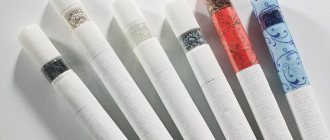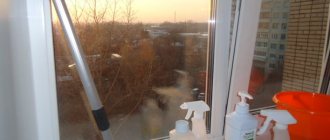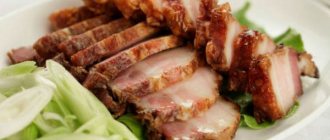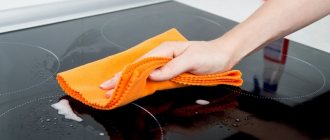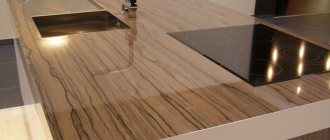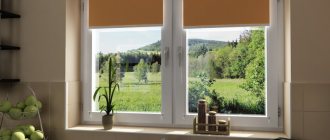Plastic panels are the most popular finishing material for renovations due to their strength, durability and low cost. The panels can be purchased in any color at your nearest hardware store for very little money. However, like any surface, plastic panels are prone to contamination, which is why many have to wonder how to wash plastic PVC panels from grease and other types of contaminants.
Types of panels
Before washing plastic PVC panels from dirt and limescale, you should determine their type. There are two types of panels: matte and glossy.
Glossy panels are coated with a special varnish that protects the coating from external negative environmental influences, so the plastic can withstand vigorous cleaning. The same cannot be said about matte panels. Due to their coating structure, the panels are more susceptible to contamination and are also sensitive to cleaning with chemicals, as a result of which they may lose their design and brightness of colors. It is for this reason that matte PVC panels are less popular than glossy ones.
It is worth noting that matte panels are recommended to be cleaned exclusively with a vacuum cleaner and dry cleaning.
Rust and limescale removers
To clean rust or lime, you can use the following foams and creamy products:
- Dosya;
- Mister Muscle;
- Xylitol Bang;
- Domestos.
Also interesting: Vinegar and soda ash are folk remedies for cleaning the bathtub
These should be non-abrasive compounds with a soft, gentle structure that will not damage the laminated coating of the panels.
Attention!
When working with aggressive cleaning agents, you must use rubber gloves. You can purchase durable medical gloves, as they will not tear longer.
Reasons for panel contamination
Due to the fact that plastic PVC panels are mainly used for finishing walls and ceilings in toilets, bathrooms and kitchens, they are characterized by the following types of pollution:
- Mold fungi.
- Rust stains from old plumbing.
- Dried splashes of water, soap and shampoo.
- Dirt and dust in hard-to-reach places.
- Construction dirt.
Important! Rusty leaks can only be solved by replacing old plumbing fixtures.
Preventive actions
Elimination of the listed problem situations involves the following actions:
- installation of forced hoods, which prevents the formation of condensation
- Minimizing fat and oil deposits using a range hood
- timely repair of roofs, pipes, taps
- regular wet cleaning of the premises to prevent dust from settling
- mosquito nets on windows to prevent insects from entering
[custom_ads_shortcode2]
Features of cleaning plastic
Powders with abrasive particles, as well as hard and metal brushes are absolutely not suitable for caring for plastic panels. These products can cause scratches and minor damage to the surface, which will contribute to the accelerated accumulation of dirt and the formation of limescale.
Before you start washing, you need to stock up on the following cleaning items:
- Soft acrylic sponges.
- Foam sponges.
- Rags made of soft fabric.
- Acrylic sponges.
Tools you'll need
To clean plastic from nicotine deposits, dust, grease and other contaminants, you must use only gentle, soft tools. Suitable for this:
— hard brush/rubber spatula;
- sponge made of foam rubber or melamine;
- latex gloves;
- cotton rag or other soft one;
- mop.
REFERENCE! Do not use products containing abrasives, scrapers, hard brushes, or pipe cleaners. Such tools can damage the surface. In addition, to clean plastic, you cannot use products containing acids, as they will leave streaks and stains.
Traditional cleaning products
The cleaning solution can be prepared from available products in the kitchen. Unlike purchased household chemicals, folk remedies are non-toxic and save the family budget. Let's figure out how and with what to wash plastic PVC panels using folk remedies and methods.
Soap solution
To prepare a soap solution, do the following:
- Take liquid soap or grate a bar of laundry soap into shavings.
- Pour hot water from the kettle.
- Stir the solution until the soap is completely dissolved.
- Soak a sponge in the cleaning product and begin washing the panels.
Important! It is not recommended to use washing powders and plumbing cleaners.
Baking soda
This powder is one of the best and safest cleaning agents when it comes to cleaning PVC panels, but it is recommended to wash the surface with soda very carefully, as the powder can scratch the glossy surface. To prepare the cleaning mixture, do the following:
- Dilute baking soda with warm water until a paste-like consistency is formed.
- Using a sponge, transfer the mixture to the panel and leave for several hours.
- Trying not to rub too hard, carefully remove the paste and rinse with warm water.
Vinegar and vodka
The products are excellent for single-color plastic panels and can cope with even severe dirt. However, it is worth noting that it is not recommended to use baking soda and vinegar on printed panels.
Bleach
To remove yellowness from plastic panels, you can use a bleach-based cleaning solution. To prepare the solution, do the following:
- Dissolve a couple of tablespoons of the product in a bucket of clean water.
- Dampen a soft brush or sponge in the solution.
- Using gentle movements along the length of the panel, rinse the entire surface.
- Wipe with a clean sponge and plain water to remove any remaining solution.
Ammonia
The product also does a good job of cleaning plastic, like the previous methods discussed. To do this, you need to dissolve a tablespoon of ammonia in a liter of clean water. Ammonia works best for cleaning plastic PVC panels from grease and soot.
Melamine sponge
An excellent method for removing even complex stains. The sponge is moistened with water and wiped with it over the entire problem area of the surface of the plastic PVC panels.
It is worth noting! Due to the fact that a sponge with a plastic surface can enter into a chemical reaction, before starting the cleaning procedure, it is recommended to test the product on an inconspicuous area of the panel.
Daily care and prevention
To maintain the neat appearance and shine of kitchen furniture, regular care and compliance with certain operating rules are necessary:
- After cleaning, the surface should be wiped dry, because due to excess moisture the material swells, mold may appear on it, and the PVC may peel off.
- It is recommended to install the headset in a place where there is no direct sunlight. Under the influence of ultraviolet light, the color on facades may lose saturation.
- Highly concentrated detergents must be diluted with water.
- When exposed to high temperatures, plastic becomes more flexible and expands. To prevent deformation, washing should be done with water at a temperature no higher than 40°C.
Many owners of glossy kitchen furniture recommend cleaning regularly using professional detergents to prevent stains from grease and other food from drying out.
Store products
If folk remedies are not enough to remove contamination, you will have to use household chemicals. Here is a list of the most popular means for cleaning plastic PVC panels:
- LOC made by Amway. To use the cleaning product, you need to dilute 30-40 milliliters in five liters of clean water, then use a sponge to treat the contaminated surface of the plastic panels, rinse with clean water and dry with a dry cloth.
- Mister proper. The product will do an excellent job of removing stains on plastic panels in the kitchen. It easily dissolves fat and removes organic contaminants. That is why Mister Proper is one of the best means for cleaning and washing panels from soot.
- Mister Muscle. Just like the previous product, Mister Muscle is useful in cleaning panels in the kitchen, but can also cope with stains in the bathroom.
- Cream Cif. Thanks to its creamy substance, this cleaning product will not leave scratches on the glossy surface, but at the same time will perfectly remove stubborn dirt. To use the drug, you should carefully read the instructions. It is worth noting that Cif cream does a good job of cleaning PVC panels from tobacco smoke and nicotine.
- Spray Glorix. In addition to cleansing dirt, the spray protects the surface from the appearance of fungal mold formations due to its antiseptic properties. When it comes to cleaning plastic panels in the bathroom, Glorix spray is the best solution. Just like Cif cream, this spray is great for removing traces and smell of smoking on PVC panels.
Important! Before use, be sure to read the instructions for use.
Caring for glossy surfaces
The appearance of glossy surfaces has to be “updated” much more often. The shiny plastic shows traces of grease even from the touch of your fingers. However, such a surface is easier to clean.
- Do-it-yourself major cleaning is carried out regularly and in exactly the same way as in a kitchen with laminated facades. However, in this case it is impossible to remove grease using products containing ammonia: ammonia will “eat” the gloss.
- To clean such a kitchen without streaks, be sure to use a completely dry cloth at the end of cleaning.
- But for daily cleaning, special care products or glass cleaning products are used. The latter perfectly remove grease from a glossy surface, which allows you to update the appearance of the facade at any time.
- To restore the shine of a glossy kitchen, it is best to use a special polish and a microfiber cloth.
How to wash PVC ceiling panels
In the bathroom and toilet, ceilings are most often made of PVC panels, but even in this place the surface is prone to contamination. The following reasons may contribute to this:
- Flooding by neighbors above.
- Soot and fumes, in the case of a kitchen ceiling.
- Roof leakage, in the case of apartments on the upper floors.
- Plaque from hot tap water evaporation in the bathroom.
- Traces of insects in the summer.
Before you start washing the ceiling of their plastic PVC panels, you must first prepare ceiling mops, rags, foam rubber and melamine sponges, a water container, a strong table or stepladder, and a cleaning agent.
The procedure for washing a ceiling made of PVC panels:
- Remove all cobwebs with a vacuum cleaner.
- Use a soft brush or sponge to apply the cleaning solution to a small area of the ceiling.
- Without waiting for it to dry, rinse off any remaining product with clean water and wipe the panel area dry.
- Repeat the cycle until the ceiling is completely clean.
Important! For yellowing on ceiling panels, use chlorine bleach as a cleaning agent. However, before use, it is recommended to test the surface reaction on an inconspicuous area of the ceiling.
Removing nicotine stains from fabrics
It is better to remove yellow tobacco stains immediately: under the influence of oxygen in the air, they can darken and become brown, then it will be more difficult to get rid of them.
The choice of stain removal method depends on what kind of fabric is dirty: white or colored, natural or synthetic. In any case, before working on damaged fabric in a visible place, you should try on an inconspicuous area: on a seam allowance, a hem, or the inside of a pocket. Before removing stains, the item must be cleaned of dust and dry contaminants and placed several napkins or a paper towel folded in several layers under the area to be treated.
If the stains are on the upholstery of upholstered furniture or carpet, then it is necessary to sprinkle absorbent powder around the stain: starch or talc, so that a dirty halo does not appear during processing. At the end of the procedure, the dried powder is removed with a vacuum cleaner.
Methods suitable for white fabrics
To remove a tobacco stain from a washable item of natural white fabric, prepare a mixture of egg yolk and technical ethyl alcohol. Mix the ingredients and add alcohol until the mixture reaches the consistency of thick sour cream.
The composition is applied with a cotton swab to the stain in a circular motion (from the periphery to the center) and left for 15 minutes. Then wash off the traces with alcohol and rinse the fabric with warm water. After this, the item is washed using detergent manually or in a washing machine.
If you don’t have ethyl alcohol on hand, prepare a composition from the following ingredients:
- water (500 ml);
- ammonia (5 ml or one tablespoon);
- hydrogen peroxide 3% (50 ml).
